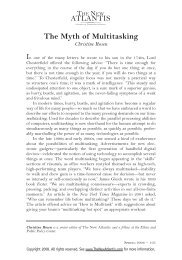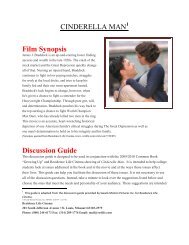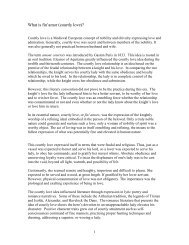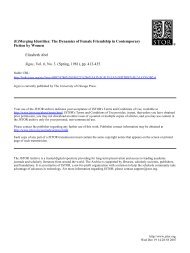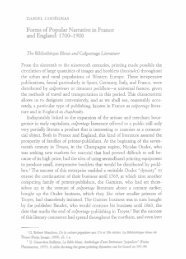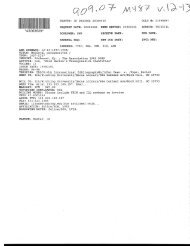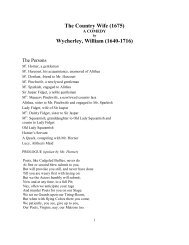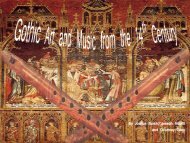Courbet's Exhibitionism
Courbet's Exhibitionism
Courbet's Exhibitionism
Create successful ePaper yourself
Turn your PDF publications into a flip-book with our unique Google optimized e-Paper software.
25 6<br />
To place <strong>Courbet's</strong> 1855 show, we must understand<br />
how rare any individual shows were in France. The most<br />
common examples of these events were the posthumous<br />
shows organized for recently deceased Academicians<br />
and held in prestigious locations such as the Ecole itself.<br />
Galleries at this time were still picture shops displaying<br />
and selling a variety of work by a variety of<br />
artists. Artists occasionally held their own shows in<br />
their studios, as David did in 1799 and Horace Vernet<br />
in 1822, but, by being held in their studios, these shows<br />
preserved the dignity of hiO art events, even when they<br />
were intended as protest t . <strong>Courbet's</strong> 1855 show has<br />
always been identified with this tradition, a protest<br />
against the Exposition Jury's refusal of his two major<br />
pictures, The Artist's Studio and A Burial at Ornans<br />
(figs. 12 and 13). And yet even before he submitted his<br />
pictures to the Jury' he had informed Nieuwerkerke, the<br />
Intendant des Beaux-Arts, that he was hoping to mount<br />
a private exhibition to compete with the Universal Ex-<br />
GAZETTE DES BEAUX-ARCS<br />
position, land he had dropped several hints to his patron<br />
Alfred Blruyas that such a show (which he wanted<br />
Bruyas to subsidize) was in the offing l 3. One could<br />
argue that he anticipated that his pictures would be rejected,<br />
but it must also be acknowledged that he very<br />
much wanted, from the beginning, to hold this show<br />
and to hold it on a site identified with the distribution<br />
of art and not its production, in other words, to hold it<br />
as a commercial enterprise. Indeed he had already made<br />
two previlous attempts in this direction in 1850, in Besanrgon<br />
and in Dijon, the first in a market hall, the second<br />
in mouse that also held a cafe. In both cases he<br />
had plastered the town with posters advertising his show<br />
and had charged a fifty centime admission fee t4 . Riat<br />
quotes him as feeling that the peasantry of Omans had<br />
thought he was an idiot because he had let them see<br />
his works! for free, "which evidently proves it's silly to<br />
have a kind heart, for it merely deprives one of funds<br />
without enriching others in spirit or purse. To be free,<br />
"Lis 0Z gBAID®S4lltflI5<br />
4.Tmm wjb~ W. lost I M-11<br />
FIG. 4. - J. JOURDAN, Le Palais de l'Industrie, Tutgis Editeur, Paris, 1855.<br />
peo<br />
swa<br />
so<br />
to t<br />
loc;<br />
in<br />
mu<br />
be,<br />
mo<br />
wh<br />
tale<br />
mu<br />
in<br />
art<br />
ye<br />
ins<br />
in<br />
tip<br />
ha<br />
te-<br />
B(<br />
di<br />
a<br />
fc<br />
tl<br />
a,<br />
R<br />
c<br />
V<br />
p<br />
e<br />
f<br />
I




